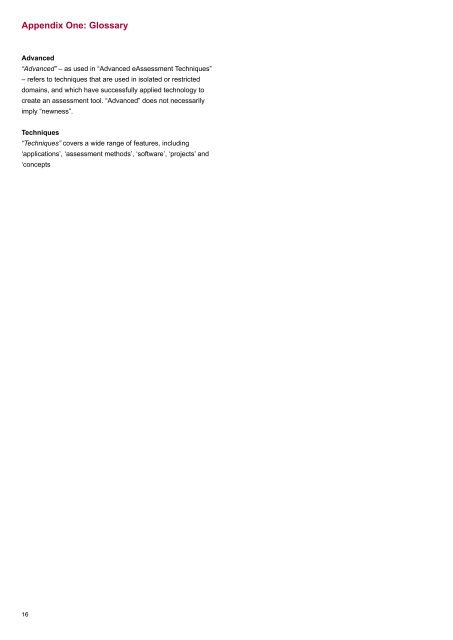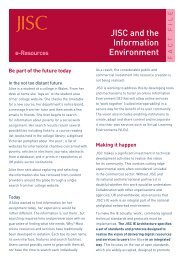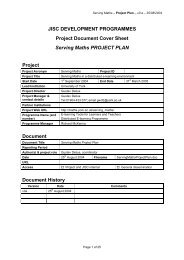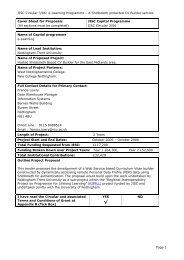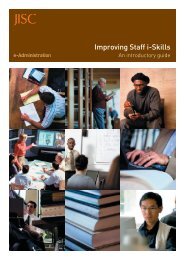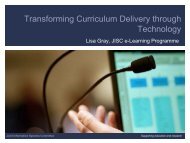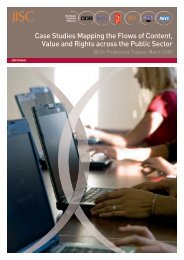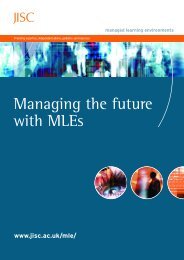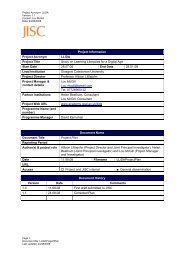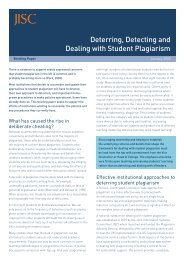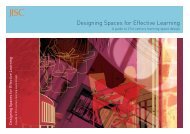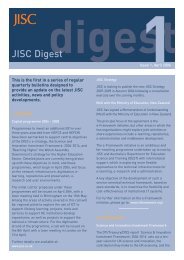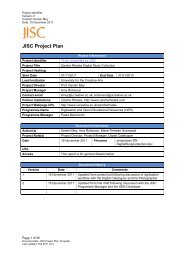Review of Advanced e-Assessment Techniques (RAeAT) Final ... - Jisc
Review of Advanced e-Assessment Techniques (RAeAT) Final ... - Jisc
Review of Advanced e-Assessment Techniques (RAeAT) Final ... - Jisc
Create successful ePaper yourself
Turn your PDF publications into a flip-book with our unique Google optimized e-Paper software.
Appendix One: Glossary<br />
Appendix Two: Extended e-assessment situation proposals<br />
<strong>Advanced</strong><br />
“<strong>Advanced</strong>” – as used in “<strong>Advanced</strong> e<strong>Assessment</strong> <strong>Techniques</strong>”<br />
– refers to techniques that are used in isolated or restricted<br />
domains, and which have successfully applied technology to<br />
create an assessment tool. “<strong>Advanced</strong>” does not necessarily<br />
imply “newness”.<br />
<strong>Techniques</strong><br />
“<strong>Techniques</strong>” covers a wide range <strong>of</strong> features, including<br />
‘applications’, ‘assessment methods’, ‘s<strong>of</strong>tware’, ‘projects’ and<br />
‘concepts<br />
The following four situation sketches are designed to illustrate aspects <strong>of</strong> assessment practice in HE institutions where e-assessment<br />
projects could be commissioned to deliver specified benefits. This approach is attractive because the assessment issues are widely<br />
understood to be issues. The approach therefore would be to use e-assessment to solve known problems, as opposed to “marketing”<br />
e-assessment on the technology benefits and enhancements.<br />
Situation 1: E-assessment targeted on known problems<br />
Possible areas for a JISC e-assessment focus:<br />
Student cheating areas<br />
This is a major problem in HE (see e.g. Smith and Ridgway, 2008). Technical approaches can never provide a complete<br />
solution, but they can help. Examples include:<br />
• the plagiarism checker Turnitin, that provides information on the likely source <strong>of</strong> each student’s essay;<br />
• Randomisation <strong>of</strong> data values within standard assessment tasks, to ensure everyone gets the same task, but with a unique<br />
data set;<br />
• The increasing use <strong>of</strong> essay mills such as bestessays where students can purchase custom-written essays shows a need<br />
for universities to keep a database <strong>of</strong> every essay written by each student, and submit them all to stylistic analyses <strong>of</strong> the<br />
sort used in literature studies. Anomalous essays can be investigated further.<br />
Inconsistent marking by staff<br />
This is a matter <strong>of</strong> concern on large courses where a number <strong>of</strong> staff share marking, and on courses that lead to national<br />
accreditation, where consistency <strong>of</strong> awarding practices across institutions is important.<br />
Situation 2: E-assessment targeted improving interactivity and motivation<br />
Possible areas for a JISC e-assessment focus:<br />
Creating innovative activities<br />
Some academics find this inherently exciting and enjoyable.<br />
Presenting students with novel challenges<br />
This can enliven teaching and learning, and forces students to target their learning on deep understanding, rather than on<br />
examination techniques<br />
16<br />
17


